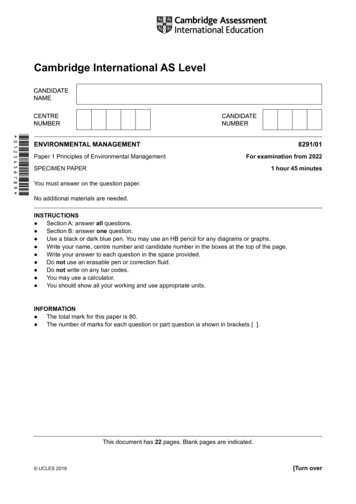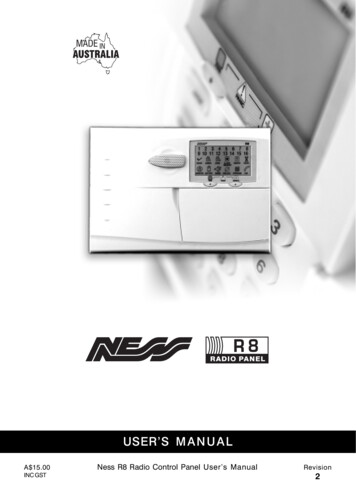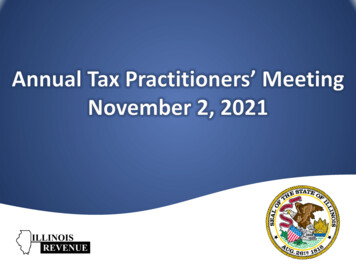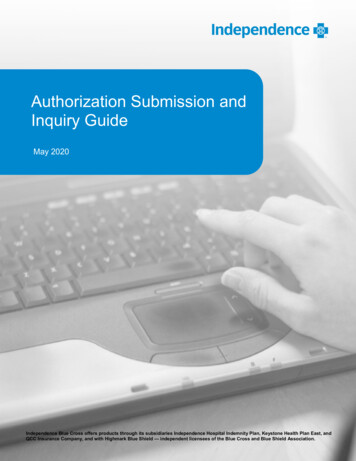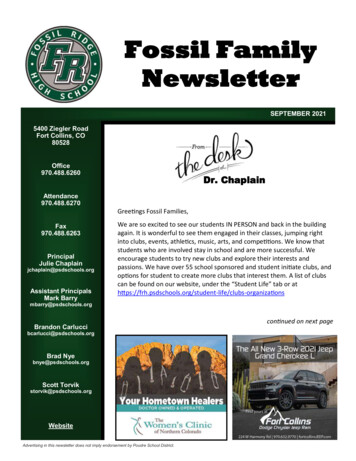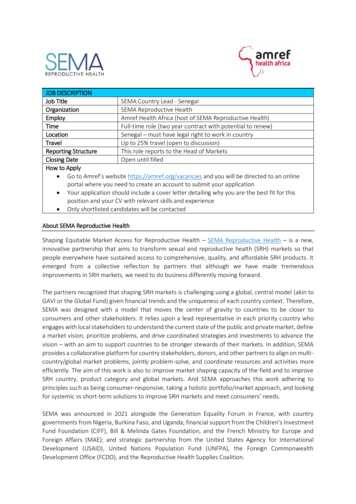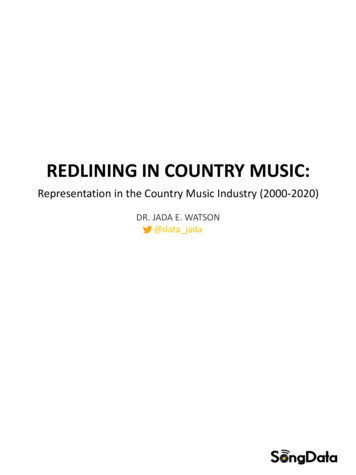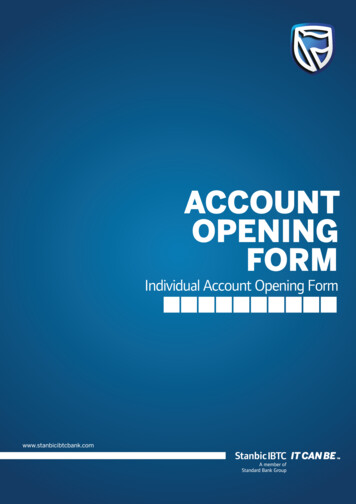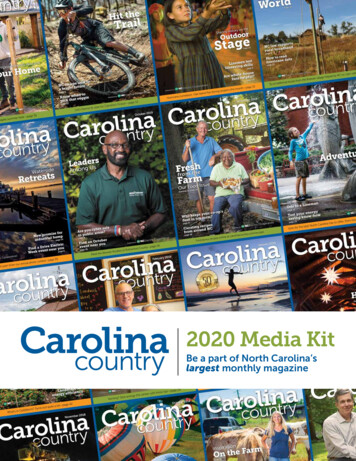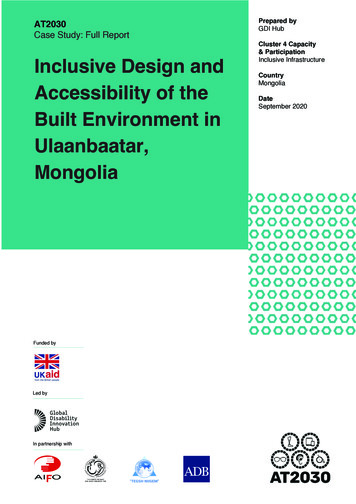
Transcription
AT2030Case Study: Full ReportInclusive Design andAccessibility of theBuilt Environment inUlaanbaatar,MongoliaFunded byLed byIn partnership withPrepared byGDI HubCluster 4 Capacity& ParticipationInclusive InfrastructureCountryMongoliaDateSeptember 2020
Inclusive Design and Accessibility of the Built Environmentin Ulaanbaatar, MongoliaAn AT2030 Case Study www.AT2030.orgSuggested citation: Patrick, M., McKinnon, I. and Austin, V. (2020) InclusiveDesign and Accessibility in Ulaanbaatar, Mongolia. AT2030 Inclusive InfrastructureCase Studies. Prepared by the Global Disability Innovation Hub and partners for theUK Foreign, Commonwealth and Development Office. DOI:10.13140/RG.2.2.26922.44485ii
Inclusive Design and Accessibility of the Built Environmentin Ulaanbaatar, MongoliaiiiAn AT2030 Case Study www.AT2030.orgSummary: Becoming a more inclusive cityUlaanbaatar city presents unique challenges and opportunities for accessible andinclusive design. The city is full of divisions between its more developed core city andthe surrounding Ger areas. The Ger areas are unplanned settlements that havegrown to become 70 percent of the city’s population in the last 30 years. These partsof the city lack access to basic infrastructure, widening inequality, impacting healthand wellbeing and presentingimmense urban developmentchallenges. The city’sarchitecture and urban planningis blending its nomadic history,20th century Soviet influencesand contemporary plans towardsa thriving technological city.These wider forces influence theextent to which disabilityinclusion can be embedded inthe built environment.Ulaanbaatar’s Ger areas surround the city centre.Image source: Google StreetviewIn 2016, Mongolia adopted the ‘Law Protecting the Rights of Persons withDisabilities’, seven years after ratifying the UNCRPD. The law marks an importantstep in making progress towards inclusion across all sectors. In the builtenvironment, this is accompanied by accessibility standards that were first developedin 2009 and are currently being updated. However, the standards are not mandatorywhich creates a barrier to implementing and enforcing them. Current understandingon accessibility and inclusion is being driven by international influences andstandards and is not fundamentally embedded in architectural training or urbandevelopment programme delivery.Ulaanbaatar’s Ger areas and unique geographical, climatic and cultural contextrequire an approach to inclusive and accessible design and planning in the builtenvironment that embeds local context and knowledge. Currently the design of
Inclusive Design and Accessibility of the Built Environmentin Ulaanbaatar, MongoliaivAn AT2030 Case Study www.AT2030.orgaccessibility is centred on basicphysical modifications such asramps and accessible toilets,inclusive design has thepotential to do much more.Inclusive design can be appliedacross the city’s urbandevelopment and planninginitiatives to integrate localperspectives and amplify thevoices of people withParticipants felt stigma in the builtdisabilities, who have some ofenvironmentthe best understanding of howthe built environment isinequitable. To ensure inclusion and equity are embedded in the built environment;urban planning, infrastructure and building projects should set a vision for inclusivedesign that can ensure consistent implementation.An inclusive built environment creates access and opportunity, allows forparticipation and builds equity in society. It is the result of collaborate efforts acrosssociety to ensure that no one is left behind. There is appetite for making Ulaanbaatarmore inclusive across policy, built environment industry and community stakeholdersand a reasonable understanding of the wider benefits of inclusive design. Setting acomprehensive vision and action plan for a more inclusive Ulaanbaatar should becomplemented by training and education in disability inclusion and inclusive designacross stakeholders and the general public. These steps would allow the city’sdesign and development to accommodate and celebrate diversity, improving the livesof everybody: including people with disabilities.“An inclusive and accessible Ulaanbaatar is somewhere that can beexperienced by everybody in a fair and equal way. By creating safe andaccessible environments for all members of the community the city can alloweveryone to access and participate in the opportunities they would like.”
Inclusive Design and Accessibility of the Built Environmentin Ulaanbaatar, MongoliavAn AT2030 Case Study www.AT2030.orgInclusive design should be understood as a mindset and methodology abovetechnical standards, to allow responsive and adaptive design in a rapidly changingcity. This adaptive mindset in design has the potential to engage more effectively withthe city’s rich history in nomadic ways of life, consider the different ways people wantto live in a city and respond to sustainable development challenges including climaterelated stresses associated with the extreme climate.Key Barriers People with disabilities experience physical, social and economic barriers toaccessing the built environment. The way the city is evolving leaves limited space for accessibility. Urban planningand coordinated efforts should make space to build in accessibility A lack of knowledge on the cost of inclusive design is a barrier for decisionmakers. Good quality design should not cost more Laws and policies fall through on implementation. Mechanisms are needed toensure implementation A lack of responsibility and accountability for inclusion in built environment andinfrastructure projects means existing standards are not enforced A lack of good examples of local inclusive design solutions creates a barrier tomotivating the general public and designers. Ulaanbaatar needs a vision forinclusive design.Recommended actions Find out what matters to people City stakeholders should establish a shared vision and ambition for an inclusiveand accessible Ulaanbaatar Awareness raising and education is vital. It can teach stakeholders how inclusivedesign benefits everyone and help to create a culture of inclusion. Accessibility in the built environment is not just about technical standards.Inclusive design can be beautiful and aspirational. Inclusive design is good design. Ulaanbaatar’s unique climate, culture and geography require an inclusive designstrategy that responds to those contexts
Inclusive Design and Accessibility of the Built Environmentin Ulaanbaatar, MongoliaviAn AT2030 Case Study www.AT2030.org Embed inclusive design from the start of a project and budget for it, earlierintegration is more effective Start somewhere. People need to discover for themselves how inclusive designcan make the city a better place to live.Creating enabling environmentsAn enabling environment for people with disabilitiesshould integrate: a supportive legislative environment,participation in design and decision-making, positivecultural change, an accessible and inclusive builtenvironment and access to good quality and affordableassistive technology.So what might an inclusive Ulaanbaatar look like? Mandatory accessibility standards that account for aspectrum of abilities and different disabilities Accessible and welcoming public places and servicesthat people can experience equally Access to good quality, affordable, assistive technology A culture of awareness, understanding and support forpeople with disabilities Equity of access, opportunity and participation for allAccessible outdoorexercise spaces areimportantWhat’s next?This case study outlines the key findings from four months of research on the city ofUlaanbaatar. As the first of six case studies on inclusive design and the builtenvironment in lower-and-middle-income countries, it will be built on through thefollowing case studies and go on to inform global actions on inclusive design.The findings of this report will be shared with both international and local audiencesand GDI Hub and partners plan to maintain remain active in Mongolia throughsupporting projects in country.
Inclusive Design and Accessibility of the Built Environmentin Ulaanbaatar, MongoliaviiAn AT2030 Case Study www.AT2030.orgAcknowledgementsThis report was written by Mikaela Patrick, Iain McKinnon and Vicki Austin of theGlobal Disability Innovation Hub (GDI Hub).We’d like to thank our team based in Ulaanbaatar; Tulgamaa Damdinsuren,Tamirkhuu Narangerel, Nyam-Ochir Byambadorj, Undrakhbayar Chuluundavaa,Enkhbuyant Lhagvajav and Avirmed Yamkhin for their contributions throughout theresearch case study and in producing this report. In particular, we’d like toacknowledge Tulgamaa Damdinsuren and Tamirkhuu Narangerel for their work ontranslating the report to Mongolian.We have collaborated with and been supported by the Asian Development Bank’sMongolia Resident Mission and the Social Development Thematic Group, the UrbanSector Group, and the Urban Climate Change Resilience Trust Fund team in thecourse of carrying out this case study.We’d like to thank all of the participants in the research for their enthusiasm andhonesty. It is our goal to amplify the voices of people with disabilities in our researchand we hope this report reflects your vision for a more inclusive and accessibleUlaanbaatar.We’d also like to thank the GDI Hub team who have supported the work, including;Katherine Perry, Prof. Cathy Holloway, Vicki Austin, Rosa Salazar and LouiseGebbett and finally, the members of our research advisory group who are; LuisArtieda, Prof. Richard Bibb, Rama Gheerawo, Chapal Khasnabis, Dr. Maria Kett,Sophie Morley and Julian Walker for their continued support, guidance and feedback.This research has ethical approval from University College London (UCL) and permission from theGovernment Agency for the Development of Persons with Disabilities in Mongolia.
Inclusive Design and Accessibility of the Built Environmentin Ulaanbaatar, MongoliaviiiAn AT2030 Case Study www.AT2030.orgGlobal Disability Innovation Hubwww.disabilityinnovation.comGDI Hub is a research and practice centre driving disability innovation for a fairerworld. Our vision is of a world without barriers to participation and equitableopportunity for all. We believe disability innovation is part of a bigger movement fordisability inclusion and social justice. GDI Hub works across 5 domains, research,innovation, programmes, teaching, and advocacy. We are solutions-focused expertsin; Assistive Technology; Inclusive Design; Culture and Participation. Based in EastLondon and a legacy of London 2012 Paralympic Games, we deliver world-classresearch, ideas and inventions, creating new knowledge, solutions and products, andshaping policy through co-creation, participation and collaboration. An AcademicResearch Centre (ARC) and a Community Interest Company (CIC) we are guided byan Advisory Board of disabled people. We operate in 33 countries and expect toimpact 15 million people by 2024.AIFOwww.aifo.itAIFO is a grassroots organisation with groups and regional coordination covering thewhole of Italy. It is also an international network organisation with memberassociations in India, Brazil and Mongolia and has an official relationship with theWorld Health Organisation (WHO). In Mongolia, AIFO is working since 1991 inimplementing Community Based Rehabilitation approach for people with disabilities(CBR). AIFO opened its Country Coordination Office in 1996 in Ulaanbaatar city.AIFO pursues the international slogan “Nothing about us without us” in all the actionsin country. All AIFO’s activities are implemented with the active participation ofpeople with disabilities as they are the experts. On the basis of 29 years ofexperience working in disability field in Mongolia, AIFO recognises the potentialpeople to contribute to the development of disability sector and has a long history oftraining and support.
Inclusive Design and Accessibility of the Built Environmentin Ulaanbaatar, MongoliaixAn AT2030 Case Study www.AT2030.orgTegsh NiigemTegsh Niigem NGO was established in 2006 to contribute to improve quality of life ofthe persons with disabilities through Community Based Rehabilitation approach(CBR) for people with disabilities and implementing UN Convention on the rights ofthe persons with disabilities (UNCRPD). Tegsh Niigem implemented sub-grantproject on the employment of people with disabilities under GSP scheme and hasimplemented two EU co-funded projects in collaboration with AIFO and other nationalDPOs. Tegsh Niigem also contributed to elaborate the new law on the rights ofpersons with disabilities, which was adopted by the Parliament of Mongolia in 2016.Since January 2017, Tegsh Niigem is member of the National Steering Committee ondisability, headed by the Minister of Labor and Social Protection. Tegsh Niigem NGOhas submitted two shadow reports to the UNCRPD Committee in 2015 and 2018.Universal Progress ILCThe Universal Progress Center is the first independent living center in Mongoliacreated by people with disabilities. The center aims to create an inclusiveenvironment for everyone, promote the social participation of people with disabilities,provide services to support independent living, and empowering its members. Thecenter currently having over 140 members with different type of disabilities and 17staffs. 12 of those staffs are disabled people. Our center is running following fourprograms: Independent living, social participation, infrastructure accessibility andinclusive education for people with disabilities.Asian Development Bankwww.adb.orgADB is committed to achieving a prosperous, inclusive, resilient, and sustainableAsia and the Pacific, while sustaining its efforts to eradicate extreme poverty.Established in 1966, it is owned by 68 members—49 from the region. Its maininstruments for helping its developing member countries are policy dialogue,loans, equity investments, guarantees, grants, and technical assistance.
An AT2030 Case Study www.AT2030.orgContentsForeword1Glossary of Key Terms3Acronyms and Abbreviations4AT2030 and Inclusive Infrastructure Programme Background5About AT20305About Inclusive Infrastructure5Why does ‘inclusive infrastructure’ matter?6Why focus on cities in low-resource settings?9Meeting global goals?10Why inclusive design?11What do we want to find out?12Introduction to the Case Study in Mongolia14Background and Contextual Factors17Disability and Accessibility in Mongolia17Culture and History in Ulaanbaatar’s Development22Urban Development and Living Conditions23Health, Environment and Climate28Summary of activities30Who has a stake in inclusive design and an accessible builtenvironment in Mongolia?32Pathway to inclusion – where are they?33Insights34Lived Experience of Disability in Ulaanbaatar34Urban Development, Infrastructure and Land38Transport, mobility and the continuity of accessibility41From policy to action – accountability and implementation43Adaptive and collaborative approaches to inclusive city-making46Inclusive Design47Assistive Technology and the Inclusive Design of the Built Environment53Enabling environments: awareness, education, and participation54
An AT2030 Case Study www.AT2030.orgTowards a more inclusive cityLessons learned5759What works and what matters?60What have we learned about access to assistive technology and the built environment?62Setting Priorities62Identifying tangible actions62Limitations and areas for further exploration67Pathway to inclusion – where are they going?68Conclusion: Actions toward inclusion69Creating enabling environments71What’s next?72References73
An AT2030 Case Study www.AT2030.org1Foreword“BECOMING A MORE INCLUSIVE CITY”The Government of Mongolia ratified UN Convention on the Rights of Persons withDisabilities in 2009 and has been successfully fulfilling its international obligations.The State Great Khural of Mongolia adopted the national Law on the Rights ofPersons with Disabilities in 2016 aiming to improve the policy and legal environmentfor ensuring the rights, participation, and protection of persons with disabilities andpublic service accessibility.In 2017, the Government of Mongolia elaborated the National Program to Supportthe Rights, Participation and Development of Persons with Disabilities in order totackle different issues including health, education, employment, and accessibility ofpublic transportation, roads, housing, and public facilities through implementingconventions and laws to ensure inter-sectorial cooperation and coordination.Currently we are elaborating a draft Law on Accessibility to eliminate barriers forpersons with disabilities to live independently and to create an accessibleenvironment in terms of infrastructure and public services.The terms of “accessibility” and “inclusive design” are quite new to Mongolia,however, governmental and non-governmental organizations, citizens, andinternational organizations are carrying out research, situation analysis,recommendations for creating inclusive society. The research on understandingInclusive and Accessible Environments in Mongolia, led by The Global DisabilityInnovation Hub (GDI Hub) and University College London in partnership with theItalian Association Friends of Raoul Follereau (AIFO) and supported by local NGOs Tegsh Niigem NGO and “Universal Progress” Independent Living Centre iscontributing greatly to the development of the policy of the country, especially inoverall process of elaborating a Law on Barrier-free and Accessibility, and planning,developing, implementing, and monitoring the state policies, programs, and actionsensuring the rights of persons with disabilities and creating more inclusive society.We are highly confident that we can develop “Inclusive Ulaanbaatar”, whichpromotes human rights, full participation of all the population ensuring activeparticipation, opinions and voices of many different stakeholders from government,non-governmental organizations and society.E.TamirDirector of General Authority for theDevelopment of Persons with Disabilities
2An AT2030 Case Study www.AT2030.orgForewordAccessible environments and inclusive design are understood as the domain ofpersons with disabilities and are often just seen as a ramp or accessible toilet. Theconcept should be seen more broadly in relation with social development. In otherwords, accessible environment and inclusive design should apply to all sectorsincluding policy making, decision making, activities, technology, education, socialprotection, tourism and services. The issue is becoming an essential challenge tostate and city development. However, countries have different cultural contexts andways of life that should be considered and social life for everyone must be on equalbasis.The Global Disability Innovation Hub (GDI Hub) is leading the research onunderstanding Inclusive and Accessible Environments in six selected countries withthe help of the partners involved in the broader AT2030 programme that has beenfunded by the UK’s Foreign, Commonwealth and Development Office (FCDO). InMongolia, the research is conducted in partnership with the Italian AssociationFriends of Raoul Follereau (AIFO) and supported by local NGOs - Tegsh NiigemNGO and “Universal Progress” Independent Living Centre.The recommendations that have come out from the research will give us ideas and abaseline to implement inclusive design in Mongolia. It will also contribute to otherinitiatives such as the development of an accessibility law and decision-makingprocesses among stakeholders.Furthermore, we are also very appreciative for how this research could contribute tothe implementation of the Sustainable Development Goals (SDG 2030) in Mongolia.We would like to express our deepest gratitude to GDI Hub and AIFO, who gave usopportunity to raise our voice in this global research.L. EnkhbuyantChair of Tegsh Niigem NGOLiving CenterCh.Undrakhbayar“Universal Progress” Independent
An AT2030 Case Study www.AT2030.org3Glossary of Key TermsInclusive Design - can help all human beings experience the world around them ina fair and equal way by creating safe and accessible environments for all membersof the community. Inclusive design is a mindset, a methodology that embracesdiversity to create a world that is more intuitive, elegant and usable for all of us.Infrastructure - is the physical and organisational structures, services and facilitiesthat support society. Good infrastructure should contribute to inclusive prosperity,including health and wellbeing. The term often refers to; transport, water and wastewater systems, energy and telecommunications industries, and social welfarestructures such as health, education and social support systems1. For the purpose ofthis report all structures (whether physical, institutional or digital) that contribute tothe participation of people with disabilities in daily life and society fall under the remitof infrastructure.Inclusive and Accessible Infrastructure and Environments - promote access,opportunity, participation and equity in society. Inclusive and accessibleinfrastructures and environments take into account the principles of inclusive design,embracing diversity and acknowledging that designing for people who experiencethe least equity in the built environment, such as people with disabilities, has thepotential to benefit all of us.People with Disabilities – throughout this report the term people with disabilities isused as it is more common internationally, but we acknowledge that in the UK theterm ‘disabled people’ is preferred.1Anjlee Agarwal and Andre Steele, ‘Disability Considerations for Infrastructure Programmes’ (Evidence onDemand, 8 March 2016), https://doi.org/10.12774/eod hd.march2016.agarwaletal.
An AT2030 Case Study www.AT2030.orgAcronyms and AbbreviationsADB: Asian Development BankAIFO: Italian Association of the Friends of Raoul FollereauAT: Assistive TechnologyAT2030: UK Aid-funded programme, ‘Testing what works to enable access to lifechanging assistive technology for all’DPO: Disabled Persons’ OrganisationFCDO: Foreign, Commonwealth and Development Office (incorporating what wasformally known as DFID)GDI Hub: Global Disability Innovation HubILC: Independent Living CentreLMICs: Lower-and-Middle-Income CountriesNUA: New Urban AgendaPwD: Persons with DisabilitiesSDGs: the UN’s Sustainable Development GoalsWASH: Water, Sanitation and HygieneWHO: World Health OrganisationUN: United NationsUNCRPD: United Nations Convention on the Rights of Persons with Disabilities4
An AT2030 Case Study www.AT2030.org5AT2030 and Inclusive InfrastructureProgramme BackgroundAbout AT2030This case study is part of the FCDO UK Aid-funded ‘AT2030: Life-changingassistive technology for all’ programme. The AT2030 programme aims to explore‘what works’ to increase access to life changing assistive technology (AT) for all. TheWorld Health Organisation (WHO) estimates that there are currently 1 billion peoplearound the world who need assistive technologies, but 90% of them do not haveaccess, and this figure is project to rise to 2 billion by 2050. The programme aims toreach 9 million people directly and 6 million indirectly through activities that cutacross the domains of data and evidence, innovation, country implementation andcapacity and participation. The programme is currently operational in 33 countriesand works with a wide range of delivery partners2.About Inclusive InfrastructureThe Inclusive Infrastructure sub-programme of AT2030 responds to the idea thatsuccessfully reaching all the people that need assistive technology is also dependenton supporting accessible and inclusive environments and infrastructure.GDI Hub believe that ‘Inclusive Design’ has an important role in facilitating enablingenvironments for people with disabilities3. Research on the current state ofaccessibility in different cities around the world and the capacity and appetite forinclusive design in policy and industry in those places is needed both to enablebetter access to assistive technology and contribute to the inclusion and participationof all assistive technology users in society.Current knowledge around disability inclusion and inclusive design is largely limitedto high income settings4. This research aims to counter that by building local andspecific knowledge of what constitutes an inclusive environment in diverse, lowerand-middle-income countries (LMICs) by engaging directly with communities,industry and policy makers. This will build knowledge and generate actions aroundFor further information on the AT2030 programme please visit http://www.at2030.orgFor more information on GDI Hub’s approach to inclusive design please e-design4 Infrastructure and Cities for Economic Development (ICED), ‘Delivering Disability Inclusive Infrastructure in LowIncome Countries’, Inception Report: Summary, 2019.23
An AT2030 Case Study www.AT2030.org6inclusive design that is adaptive to these diverse contexts. Research will take placein three areas:1. The community experience of disability and the built environment;2. Industry focused research on the awareness and application of inclusivedesign in practice; and3. Policy focused research on the governance, guidelines and protocols ofaccessibility and inclusive design at the higher levels.Through qualitative and participatory research, the project will engage diversestakeholders interested in and influencing the built environment such as; decisionmakers, urban planners, architects and Persons with Disabilities. It will generate newinsights on the challenges and opportunities for an inclusive built environment andinclusive and accessible infrastructures and build a picture of what good inclusivedesigns looks like in different settings and cultures.Inclusive Infrastructure summary: Three-year research programme6 cities in 6 different countries, in low-and-middle-income settingsEngaging local partners and diverse stakeholdersConducting research and engagement across the domains of policy, industry andpeople for inclusion in the built environmentWhy does ‘inclusive infrastructure’ matter?‘Access’, in its various forms, is a primary factor in the connection between disabilityand poverty. Where there is a lack of access, such as access to employment, accessto essential infrastructure such as water or electricity, or access to safe spaces forwomen, inequality and social exclusion will increase. This can be both a cause oreffect of either disability or poverty and is described as a ‘vicious cycle’5, reinforcingthe relationship between disability and poverty6 7. For example, in Mongolia,households with at least one person with a disability have double the povertyDepartment for International Development, UK Government, ‘Disability, Poverty and Development’ (Departmentfor International Development, 2000).6 Christoffel J. Venter, Thomas E. Rickert, and David A. C. Maunder, ‘From Basic Rights to Full Access:Elements of Current Accessibility Practice in Developing Countries’, Transportation Research Record:Journal of the Transportation Research Board 1848, no. 1 (January 2003): 79–85,https://doi.org/10.3141/1848-11.7 Department for International Development, UK Government, ‘Disability, Poverty and Development’.5
An AT2030 Case Study www.AT2030.org7incidence of other households8. Research on the multi-dimensional nature of povertyhas also shown higher incidences of poverty in households with disabilities inmiddle-income settings compared to low-income settings, indicating a ‘disabilitydevelopment gap’9 and making clear the importance of disability inclusivedevelopment programmes.People have a right to access the spaces, services and activities they would like,accessibility is a right that is set out in the UNCRPD10. Access can be either enabledor disabled by the built environment and infrastructure and this is understood best bythose who experience inaccessibility in the built environment most profoundly,people with disabilities11. To break cycles of disability and inequality, it is necessaryto design accessible and inclusive environments. To do that there must beconsensus on what barriers to accessibility exist in the built environment and whatthe barriers to designing, building, implementing and regulating accessibleenvironments are. Justice-based approaches to disability and the built environmentpropose that, ‘the distribution of space is an important aspect of realizing justice fordisabled persons’12 highlighting the importance of designing and building inclusiveinfrastructure for creating more equitable societies.Infrastructure, transport and the built environment represent one of the largest areasof investment for any country and ‘good’ infrastructure can be a driving force forpositive change and achieving development goals. Infrastructure should be designedto support society. However, if it is inaccessible, it can exclude individuals or groups,diminish quality of life and infringe on human rights.In lower-resourced settings, where basic infrastructure needs are great, accessibilityis often taken as an extra and is rarely integrated as part of infrastructuredevelopment13. Inaccessible infrastructure profoundly impacts the freedom,independence and rights of people with disabilities and their ability to accessAsian Development Bank, ‘Living with Disability In Mongolia: Progress Toward Inclusion’ (Manila, Philippines:Asian Development Bank, December 2019), https://doi.org/10.22617/TCS190596-2.9 Monica Pinilla-Roncancio and Sabina Alkire, ‘How Poor Are People With Disabilities? Evidence Based on theGlobal Multidimensional Poverty Index’, Journal of Disability Policy Studies, 17 May 2020,104420732091994, https://doi.org/10.1177/1044207320919942.10 Disability Inclusive and Accessible Urban Development Network (DIAUD), World Enabled, and CBM, ‘TheInclusion Imperative: Towards Disability-Inclusiv
Artieda, Prof. Richard Bibb, Rama Gheerawo, Chapal Khasnabis, Dr. Maria Kett, Sophie Morley and Julian Walker for their continued support, guidance and feedback. This research has ethical approval from University College London (UCL) and permission from the Government Agency for the Development of Persons with Disabilities in Mongolia.
